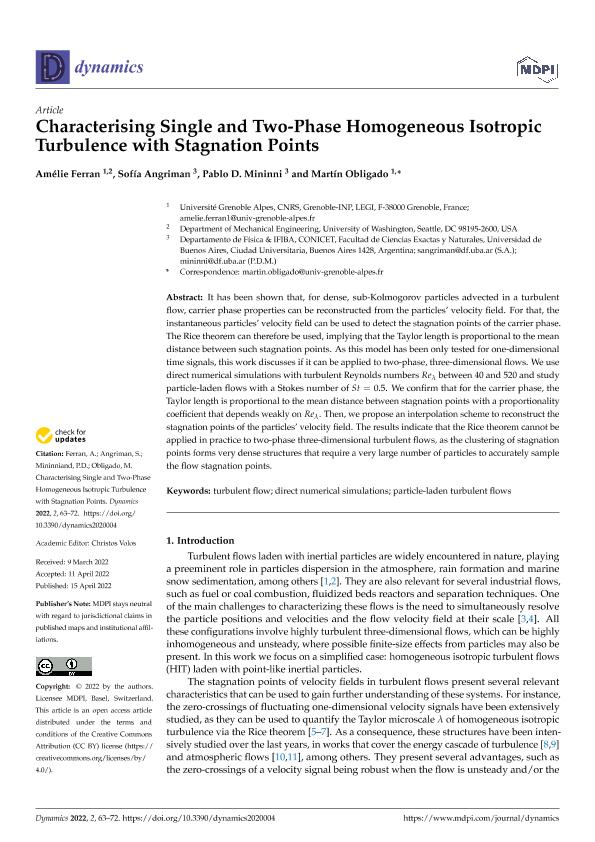Mostrar el registro sencillo del ítem
dc.contributor.author
Ferran, A.
dc.contributor.author
Angriman, Sofia

dc.contributor.author
Mininni, Pablo Daniel

dc.contributor.author
Obligado, M.
dc.date.available
2023-08-30T15:26:30Z
dc.date.issued
2022-04
dc.identifier.citation
Ferran, A.; Angriman, Sofia; Mininni, Pablo Daniel; Obligado, M.; Characterising Single and Two-Phase Homogeneous Isotropic Turbulence with Stagnation Points; MDPI; Dynamics; 4-2022; 1-10
dc.identifier.issn
2673-8716
dc.identifier.uri
http://hdl.handle.net/11336/209925
dc.description.abstract
It has been shown that, for dense, sub-Kolmogorov particles advected in a turbulent flow, carrier phase properties can be reconstructed from the particles’ velocity field. For that, the instantaneous particles’ velocity field can be used to detect the stagnation points of the carrier phase. The Rice theorem can therefore be used, implying that the Taylor length is proportional to the mean distance between such stagnation points. As this model has been only tested for one-dimensional time signals, this work discusses if it can be applied to two-phase, three-dimensional flows. We use direct numerical simulations with turbulent Reynolds numbers Reλ between 40 and 520 and study particle-laden flows with a Stokes number of St = 0.5. We confirm that for the carrier phase, the Taylor length is proportional to the mean distance between stagnation points with a proportionality coefficient that depends weakly on Reλ. Then, we propose an interpolation scheme to reconstruct the stagnation points of the particles’ velocity field. The results indicate that the Rice theorem cannot be applied in practice to two-phase three-dimensional turbulent flows, as the clustering of stagnation points forms very dense structures that require a very large number of particles to accurately sample the flow stagnation points.
dc.format
application/pdf
dc.language.iso
eng
dc.publisher
MDPI
dc.rights
info:eu-repo/semantics/openAccess
dc.rights.uri
https://creativecommons.org/licenses/by/2.5/ar/
dc.subject
TURBULENT FLOW
dc.subject
DIRECT NUMERICAL SIMULATIONS
dc.subject
PARTICLE-LADEN TURBULENT FLOWS
dc.subject.classification
Física de los Fluidos y Plasma

dc.subject.classification
Ciencias Físicas

dc.subject.classification
CIENCIAS NATURALES Y EXACTAS

dc.title
Characterising Single and Two-Phase Homogeneous Isotropic Turbulence with Stagnation Points
dc.type
info:eu-repo/semantics/article
dc.type
info:ar-repo/semantics/artículo
dc.type
info:eu-repo/semantics/publishedVersion
dc.date.updated
2023-07-07T22:17:38Z
dc.journal.pagination
1-10
dc.journal.pais
Suiza

dc.description.fil
Fil: Ferran, A.. Universite Grenoble Alpes; Francia
dc.description.fil
Fil: Angriman, Sofia. Consejo Nacional de Investigaciones Científicas y Técnicas. Oficina de Coordinación Administrativa Ciudad Universitaria. Instituto de Física de Buenos Aires. Universidad de Buenos Aires. Facultad de Ciencias Exactas y Naturales. Instituto de Física de Buenos Aires; Argentina
dc.description.fil
Fil: Mininni, Pablo Daniel. Consejo Nacional de Investigaciones Científicas y Técnicas. Oficina de Coordinación Administrativa Ciudad Universitaria. Instituto de Física de Buenos Aires. Universidad de Buenos Aires. Facultad de Ciencias Exactas y Naturales. Instituto de Física de Buenos Aires; Argentina
dc.description.fil
Fil: Obligado, M.. Universite Grenoble Alpes; Francia
dc.journal.title
Dynamics
dc.relation.alternativeid
info:eu-repo/semantics/altIdentifier/doi/https://doi.org/10.3390/dynamics2020004
Archivos asociados
